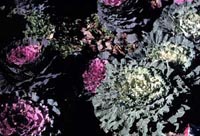Resource Library
Plant of the Week: Ornamental Kale (Flowering Cabbage)
The University of Arkansas System Division of Agriculture does not promote, support or recommend plants featured in "Plant of the Week." Please consult your local Extension office for plants suitable for your region.
Plant of the Week
Ornamental Kale, Flowering Cabbage
Latin: Brassica oleracea var. acephala

As gardeners, we’re spoiled by the wide variety of flowering plants for the spring
garden. Then fall arrives. Instead of a rich and varied assortment, we have pansies
and chrysanthemums in multi-colored hues and very little else. But along with these
mainstays of fall, we do have a few minor color items such as the ornamental kales.
Ornamental kale is essentially the same as the kale grown in the vegetable garden,
except the ornamental types have been bred to have showy white or reddish-purple leaves.
Kale, which a member of the cabbage family, is fundamentally a cabbage that does not
produce a head. Instead, it produces leaves in a tight rosette.
The ornamental kales are biennial, which means they produce leaves one year and flowers
the next. The plants can get about 18 inches tall their first year. While the ornamental
types are technically all kales, by convention the forms with deeply cut incised leaves
are called "ornamental kale," while the types with a rounded leaf are called "ornamental
cabbage."
The common name "flowering cabbage" is misleading because we don’t grow these plants
for their flowers, just their showy leaves. If we have a mild winter with temperatures
that don’t drop below 15 degrees, the plants will overwinter and produce white, four-petaled
flowers on tall stalks. But it doesn’t get that cold very often in most parts of the
state, and anyway, the flowers are ugly.
Kale is the Scottish name. It’s adapted from the Roman name cole. The ancient vegetable
has been grown for at least 4000 years. All members of the cabbage tribe originated
in the Mediterranean region and were scattered to all corners of the world by early
travelers.
Kale made its way to China, probably by the 4th century, where it and several relatives
became a staple of the Chinese diet. The plants eventually made their way to Japan
where ornamental leaf types were selected. They became popular in gardens after the
17th century.
In 1929, the U.S. Department of Agriculture sent Howard Dorsett to China and Japan
in search of new plants. One of his introductions was the ornamental kales from Japan.
The plants first appeared in seed catalogs in 1936, giving us a new item for the fall
garden.
The correct season for planting ornamental kale has been debated. In areas with cool
summers and far northern locations with early frosts, it’s best grown as a summer
annual. In the South with our hot summers but long, mild falls, autumn planting is
best.
The leaves of ornamental kale are edible. They’re often used as garnish on plates
in place of parsley.
In the garden, ornamental kale is used as a front-of-the-border plant, or sometimes
for massing in public displays. It should have fertile soil that’s well drained. It
should be situated where it gets at least six hours of sunlight. Ornamental kale can
also be grown in pots as a patio plant.
The plant’s main nemesis is the cabbage looper. The green worm is the larval stage
of a white moth often seen flying above plants with jerky movements at egg-laying
time. The insect can riddle the leaves with holes in just a few days. Spraying with
Sevin or dusting with BT spores provides effective control.
By: Gerald Klingaman, retired
Extension Horticulturist - Ornamentals
Extension News - October 6, 2000
The University of Arkansas System Division of Agriculture does not maintain lists of retail outlets where these plants can be purchased. Please check your local nursery or other retail outlets to ask about the availability of these plants for your growing area.